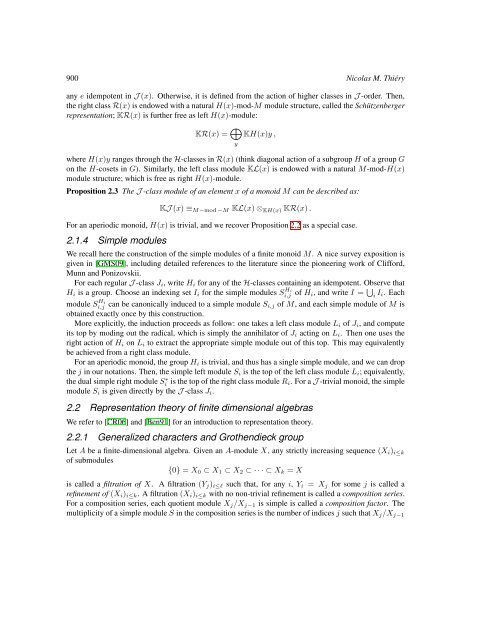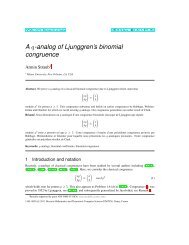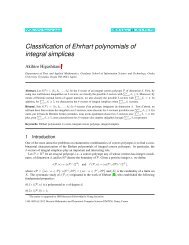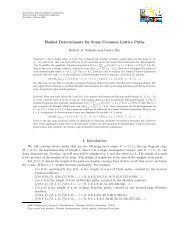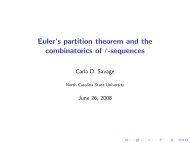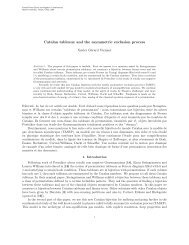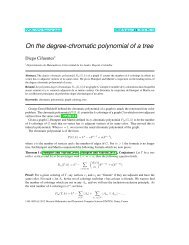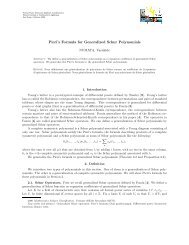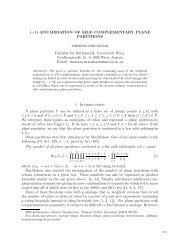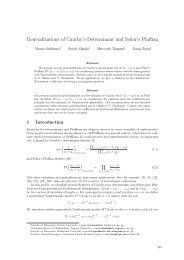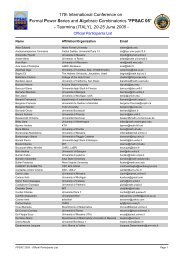Cartan invariant matrices for finite monoids - Nagoya University
Cartan invariant matrices for finite monoids - Nagoya University
Cartan invariant matrices for finite monoids - Nagoya University
Create successful ePaper yourself
Turn your PDF publications into a flip-book with our unique Google optimized e-Paper software.
900 Nicolas M. Thiéry<br />
any e idempotent in J (x). Otherwise, it is defined from the action of higher classes in J -order. Then,<br />
the right class R(x) is endowed with a natural H(x)-mod-M module structure, called the Schützenberger<br />
representation; KR(x) is further free as left H(x)-module:<br />
KR(x) = ⊕ y<br />
KH(x)y ,<br />
where H(x)y ranges through the H-classes in R(x) (think diagonal action of a subgroup H of a group G<br />
on the H-cosets in G). Similarly, the left class module KL(x) is endowed with a natural M-mod-H(x)<br />
module structure; which is free as right H(x)-module.<br />
Proposition 2.3 The J -class module of an element x of a monoid M can be described as:<br />
KJ (x) ≡ M−mod −M KL(x) ⊗ KH(x) KR(x) .<br />
For an aperiodic monoid, H(x) is trivial, and we recover Proposition 2.2 as a special case.<br />
2.1.4 Simple modules<br />
We recall here the construction of the simple modules of a <strong>finite</strong> monoid M. A nice survey exposition is<br />
given in [GMS09], including detailed references to the literature since the pioneering work of Clif<strong>for</strong>d,<br />
Munn and Ponizovskii.<br />
For each regular J -class J i , write H i <strong>for</strong> any of the H-classes containing an idempotent. Observe that<br />
H i is a group. Choose an indexing set I i <strong>for</strong> the simple modules S Hi<br />
i,j of H i, and write I = ⋃ i I i. Each<br />
module S Hi<br />
i,j can be canonically induced to a simple module S i,j of M, and each simple module of M is<br />
obtained exactly once by this construction.<br />
More explicitly, the induction proceeds as follow: one takes a left class module L i of J i , and compute<br />
its top by moding out the radical, which is simply the annihilator of J i acting on L i . Then one uses the<br />
right action of H i on L i to extract the appropriate simple module out of this top. This may equivalently<br />
be achieved from a right class module.<br />
For an aperiodic monoid, the group H i is trivial, and thus has a single simple module, and we can drop<br />
the j in our notations. Then, the simple left module S i is the top of the left class module L i ; equivalently,<br />
the dual simple right module Si ∗ is the top of the right class module R i. For a J -trivial monoid, the simple<br />
module S i is given directly by the J -class J i .<br />
2.2 Representation theory of <strong>finite</strong> dimensional algebras<br />
We refer to [CR06] and [Ben91] <strong>for</strong> an introduction to representation theory.<br />
2.2.1 Generalized characters and Grothendieck group<br />
Let A be a <strong>finite</strong>-dimensional algebra. Given an A-module X, any strictly increasing sequence (X i ) i≤k<br />
of submodules<br />
{0} = X 0 ⊂ X 1 ⊂ X 2 ⊂ · · · ⊂ X k = X<br />
is called a filtration of X. A filtration (Y j ) i≤l such that, <strong>for</strong> any i, Y i = X j <strong>for</strong> some j is called a<br />
refinement of (X i ) i≤k . A filtration (X i ) i≤k with no non-trivial refinement is called a composition series.<br />
For a composition series, each quotient module X j /X j−1 is simple is called a composition factor. The<br />
multiplicity of a simple module S in the composition series is the number of indices j such that X j /X j−1


